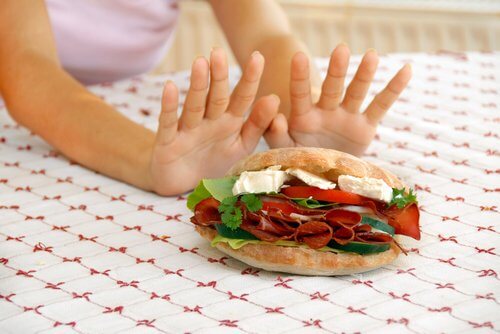How to Prevent Emotional Eating

The scene of the sad girl laying on the couch with a big container of ice cream crying in front of the television doesn’t just happen in the movies. It’s actually a very common phenomenon: emotional eating.
The situation might be different in your case. You may choose a different kind of food. On the other hand, it may be a different environment, like outside of your house. It’s true that when you feel depressed, sad, or overwhelmed, it’s easy to eat.
How can you prevent emotional eating? We’ll tell you in this article.
Why Emotional Eating Happens

When you’re stressed, you eat. Then, when you’re sad, you eat. When you feel anxious, you eat.
Why does this happen?
Human beings usually take refuge in eating when something doesn’t go well. Doing this becomes a bad habit. Unfortunately, it’s not one you can break very easily.
Depending on a food (or foods) to satisfy your emotional needs isn’t healthy. You should only eat when your body needs it from a physiological standpoint, not a psychological one. The act of eating should be influenced by your appetite and not your emotions or your mood.
Sometimes, you think that if your stomach growls and hurts you’re hungry. As a result, you feel you need to eat. However, many times your mind or emotions give this signal. This is because both are accustomed to getting a quick reward.
Immediate relief through food can be a double-edged sword. This is due to the fact that each time you’re going to need more to get the same result. This is the same thing that happens with drugs.
The bad thing is that you can’t always differentiate between a physiological need when your brain starts craving something that produces substances related to pleasure. Because of this, your mind will always look for a similar reward. And when you find food… you’ll eat it. It doesn’t matter if you aren’t hungry or just finished lunch.
This is where the emotional eating habit forms and will be harder to break.
How to Prevent Emotional Eating

Each one of us has what psychologists call “comfort foods.” This means the foods that you choose for certain moments or with certain emotions.
For instance, when you fight with your partner, you may eat chocolate. When you’re anxious or bored, you may eat french fries. Or, when you’re feeling depressed, you may turn to ice cream and cookies.
Read more: How to Make Healthy and Light French Fries
Doesn’t it seem strange that no one comforts themselves with a carrot, tomato, or an apple?
The difference comes from the fact that fruits and vegetables don’t have high levels of fat. Because of this, they don’t satisfy you (or better said, they don’t satisfy your brain).
This is the first red flag that you should notice to prevent emotional eating.
The steps that help you break this habit are:
1. Determine if you’re really hungry
This is the hardest step of all. However, once you get it, the rest of the steps will look as easy as pie.
If you’re paying attention, you’ll notice that sadness often causes emotional eating. These are things that during other times of the day, or stages of life, would never pass through your head.
Physical hunger is gradual, but it can wait. It’s open to various menu options. This feeling doesn’t cause negative feelings and the only important thing is satisfying it.
On the other hand, emotional hunger is sudden and urgent. It wants specific foods. This feeling makes you feel guilt or shame. Plus, it never gets satisfied.
Another way to determine if it’s really hunger or not has to do with the amounts.
When your appetite is physical, you’ll probably feel satisfied with less food. If it’s emotional, you’ll turn into a “bottomless pit.” Then it’s likely that your stomach will hurt. You might also feel like vomiting or wanting to sleep for a few hours.
Learn to identify the difference, and you’ll be on your way to preventing emotional eating.
2. Identify when you eat “for pleasure” and your triggers

Paying attention to how you feel is very important to know if your desire to eat comes from a physical need or not.
For instance, there are some things you can look for like: doing badly on a test, doing something wrong at work, fighting with your family, etc. If each time these things happen you start to devour food, it’s likely that it’s your sadness talking and not your stomach.
Also read: What Are the Differences Between Sadness and Depression
Analyze the moments when you’re more prone to emotionally eat as objectively as possible. This helps you to get out of the kitchen or the fridge after these specific situations.
3. Hide the temptations
This might seem like very extreme advice. However, it’s very effective for the first few times you’re trying to stay away from emotional eating.
If you go to the kitchen for a piece of chocolate and the only thing you fine is an orange, you have two options: eat the orange or go back to what you were doing.
If you’re hungry for something salty and the first thing you see are french fries, what are you going to do? You eat them, of course.
Instead, if you barely open the pantry and you find rice cakes, you’ll definitely end up eating them.
Maybe this doesn’t break the habit. However, at least you’ll avoid binge eating and gaining weight because you’re eating unhealthy food.
4. Take control

You’ve already identified that you emotionally eat and when you do it. The next step is to concentrate on the other things and take the reins in the situation.
The impulse to eat when you’re sad will be very strong. You’ll need to be very strict and dedicated to yourself to win this battle.
You can try doing activities that make you happy. Or, you can do things that make you feel good. For instance, read, watch an episode of your favorite TV show or movie, listen to fun music, go for a walk, or go shopping.
There are so many options that we can’t write all of them in this article. You know better than anyone what makes you happy (and that isn’t food).
All cited sources were thoroughly reviewed by our team to ensure their quality, reliability, currency, and validity. The bibliography of this article was considered reliable and of academic or scientific accuracy.
- Mayo Clinic Staff. (2014). Feeding your feelings.
mayoclinichealthsystem.org/hometown-health/speaking-of-health/feeding-your-feelings - Mayo Clinic Staff. (2015). Weight loss: Gain control of emotional eating.
mayoclinic.org/healthy-lifestyle/weight-loss/in-depth/weight-loss/art-20047342 - Mayo Clinic Staff. (2017). Meditation: A simple, fast way to reduce stress.
mayoclinic.org/tests-procedures/meditation/in-depth/meditation/art-20045858 - Mayo Clinic Staff. (n.d.). 9 ways to curb emotional eating.
diet.mayoclinic.org/diet/motivate/ways-to-curb-emotional-eating?xid=nl_MayoClinicDiet_20151125 - Mayo Clinic Staff. (n.d.). Are you an emotional eater? [Quiz].
diet.mayoclinic.org/diet/motivate/are-you-an-emotional-eater-quiz?xid=nl_MayoClinicDiet_20171108#q=1
This text is provided for informational purposes only and does not replace consultation with a professional. If in doubt, consult your specialist.








